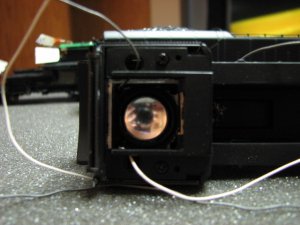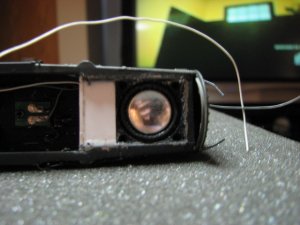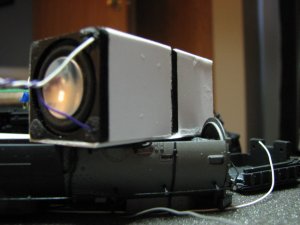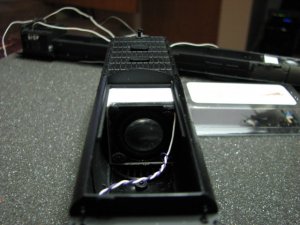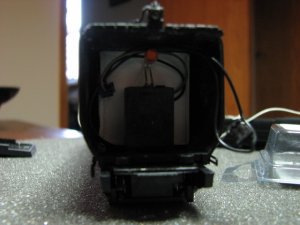You are using an out of date browser. It may not display this or other websites correctly.
You should upgrade or use an alternative browser.
You should upgrade or use an alternative browser.
Next project
- Thread starter irocinblue89
- Start date
irocinblue89
Member
goscrewyourselves
I'm the one
That's going to be able to be heard! 
irocinblue89
Member
I hope not! lol. I have to split the watts between 4 speakers. I'm actually going for effect rather than loudness. I usually turn my sound units down so I can't hear them past 5'. I just want to give a better illusion of the sound coming from the loco and not all of it from the tender.That's going to be able to be heard!
irocinblue89
Member
UUUUHHHH is all I can say about it. Underwhelming. So, if I break it down, the speakers in the tender sound amazing. The speakers in the loco are not very audible. I cut one of the speaker wires to the tender speakers so I could listen to the loco speakers and they sounded O.K. But the 2 in the tender overpower the 2 in the loco. $50 in speakers and no better off. Suggestions?
Interesting about the overpowering, I was thinking of doing something similar with a P2K, PA/PB setup I have (2 A's, 3 B's, one unpowered), in an ABBBA lash-up. Thought of sound decoders in the 2 A's and iso-baric speakers in the centre unpowered B. From what you've said it appears (won't say sounds like) that there's a need to lower the volume of the larger speakers, or adjust out the treble so that they only produce the Bass. Is that possible?
Oddly enough we just had a similar experience with a Philips TV soundbar that had removable wireless speakers you could detach from the main speaker bar, place them behind you and "enjoy" surround sound in your room. Same effect as you are getting, the rear ones drowned out the front to the point of making them inaudible. Spoken dialogue was behind you instead of in front.
Oddly enough we just had a similar experience with a Philips TV soundbar that had removable wireless speakers you could detach from the main speaker bar, place them behind you and "enjoy" surround sound in your room. Same effect as you are getting, the rear ones drowned out the front to the point of making them inaudible. Spoken dialogue was behind you instead of in front.
Last edited by a moderator:
irocinblue89
Member
Toot: Back in my days >COUGH< I vaguely remember friends talking about using resistors or another form of cheap electrical device to limit the frequency of the incoming signal to said speaker. Now, my disclaimer - I cannot recall if it was a pipe dream, if I was on something, if it was kids talking about something they knew nothing about, or whatever. If it is true, I would love to research it further. For now I think I am going to cut styrene and close off the cutouts in the bottom of the tender. That will force the sound waves to come out of the front where the drawbar connects. I am also going to sticky tack the coal load in to limit the sound coming from it.
The ohms of your speakers affect the volume they produce as well from what I've read ( this info came about when researching whether I could use my existing hardwired speakers with the Yamaha system we got to replace that disgraceful and utterly overpriced soundbar), the lower the ohms the louder the volume, so it should be possible within reason vary the ohms between the loco speakers and the ones in the tender, possibly the reason for the resistors you mention. (maybe someone that knows about this will jump in here)
bklynman01
Active Member
A resistor will lover the volume, it is true. And yes, capacitors will filter noise from the sine waves (sound). However, be careful about how you assemble these. If you put a resistor first, then a capacitor in parallel, you will build yourself a low-pass filter and nothing will come out of your speakers.
Not sure how much you understand electronics, so this may or may not help: http://en.wikipedia.org/wiki/Low-pass_filter
You can see the schematics in there, and how filters are made. Basically, avoid that type of circuit design and you'll be good.
A few simple Google searches about sine wave manipulation and you should have more information than you can handle.
Good luck!
Not sure how much you understand electronics, so this may or may not help: http://en.wikipedia.org/wiki/Low-pass_filter
You can see the schematics in there, and how filters are made. Basically, avoid that type of circuit design and you'll be good.
A few simple Google searches about sine wave manipulation and you should have more information than you can handle.
Good luck!
The lower impedance your speakers are the louder it is, but also the distortion values are doubled with each reduction in impedance of 50%. I don't know how you all can stand the sound of your models after 20 minutes or so. We had fairly good sounding LGB train in the hobby shop window and NONE OF US who worked there could stand the racket after about 1/2 hour.
irocinblue89
Member
The 4 speakers have an impedance of 8ohms. As far as the sound, I like the 5 foot rule because the club layout is big enough you do not hear the loco the whole way around. You maybe hear it 20% of the time.

